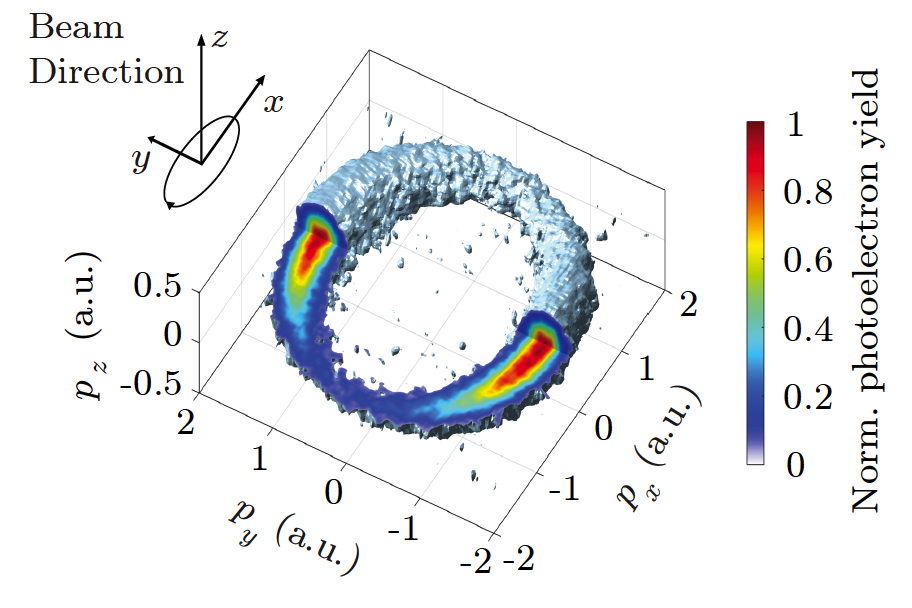Dec 6 2019
One of the most important processes in light-matter interaction is the generation of photoelectrons via ionization. But profound questions remain about the way photons convey their linear momentum to electrons.
 Reconstructed 3D photoelectron momentum distribution, together with a sketch of the polarization ellipse and the beam direction. Image Credit: Willenberg et al., Nature Communications.
Reconstructed 3D photoelectron momentum distribution, together with a sketch of the polarization ellipse and the beam direction. Image Credit: Willenberg et al., Nature Communications.
ETH physicists have now provided an unparalleled insight into the origin of photoelectrons based on the first sub-femtosecond analysis of the transfer of linear photon momentum during an ionization process.
The interplay between matter and light is the basis of various practical technologies and several underlying phenomena. Most eminently, electrons under the photoelectric effect are produced from a material exposed to light of appropriate energy.
The origin of the phenomenon continued to be a puzzle for a long time, but the introduction of quantum theory—and because of the genius of Albert Einstein—the effect was completely interpreted.
The 1921 Nobel Prize in Physics was awarded to Einstein for finding the fundamental laws. Since that time, the effect has been manipulated in various applications spanning from night-vision devices to spectroscopy.
In specific significant cases, the main principle involves the transfer of linear momentum, or impulse—and not the transfer of energy—from photons to electrons. This holds true, for example, when laser light is utilized to cool both macroscopic and microscopic objects, or if the phenomenon of radiation pressure had to be understood.
In spite of the underlying significance of momentum transfer, the accurate details of the way light transfers its impulse to matter are yet to be completely understood. One of the reasons is that the conveyed impulse alters at the time of an optical cycle on very fast, sub-femtosecond timescales.
To date, studies have mostly revealed data on time-averaged behavior and have overlooked time-reliant aspects of the linear-momentum transfer at the time of photoionization. Now, this gap has been filled by a research team of Ursula Keller at the Institute for Quantum Electronics. This has been described in a paper recently published in the Nature Communications journal.
The researchers studied the case of high laser intensities, in which numerous photons are involved in the ionization process, and explored the amount of momentum that is transmitted in the laser propagation direction.
To obtain adequate time resolution, the researchers used the so-called attoclock method, which has been advanced and refined in the Keller laboratory in the last 10 years. In the attoclock technique, attosecond time resolution was realized without the need to generate attosecond laser pulses.
As an alternative, data regarding the rotating laser-field vector in close-to-circular polarized light was utilized to quantify the time in relation to the ionization event with attosecond accuracy. Quite analogous to a clock’s hand, the hand of this clock was now rotating via a full circle within a single optical cycle of 11.3-fs duration.
Using this multipurpose tool, the ETH physicists successfully established the amount of linear momentum electrons gained based on the time the photoelectrons were “born.”
The researchers observed that the amount of momentum transmitted in the laser’s propagation direction indeed relies on the time the electron is “freed” from the matter during the laser’s oscillation cycle; in the researchers’ case, they were the xenon atoms.
This implies that at least for the case investigated by the researchers, the picture of time-averaged radiation pressure is not relevant. Interestingly, the researchers can recreate the observed behavior almost completely inside a traditional model, while several scenarios of the interaction between light and matter, like Compton scattering, can only be described within a quantum mechanical model.
However, the traditional model had to be extended to consider the interaction between the residual xenon ion and the outgoing photoelectron. Such an interaction demonstrated in the researchers’ experiments causes further attosecond delay in the timing of the linear momentum transfer as opposed to the theoretical prediction for a free electron that was born during the pulse.
The question of whether these delays are relevant only for the kind of scenarios analyzed in the current study, or whether they are a general property of photoionization, remains open at present.
But it is evident that with this initial analysis of the transfer of linear momentum during ionization on the process’ natural timescale, the Keller group has exposed a new, interesting method to investigate the very significant nature of interactions between light and matter, thus making good on a significant promise of attosecond science.